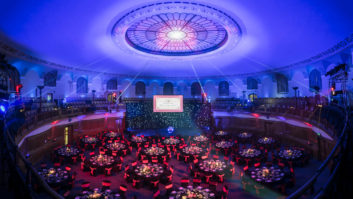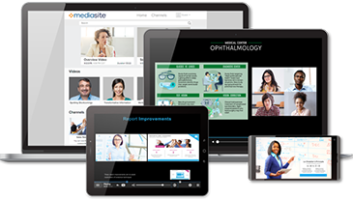Prior to the pandemic, what technologies or trends would you
say were having the most enabling impact in AV systems integration in professional workspaces?
Stijn Ooms (SO): Digital transformation is driven by people’s urge to push and expand the limits of what current and future technologies make possible. By 2025, millennials will make up 75 per cent of the workforce and their changing expectations of what an employer and workplace have to offer forces companies to rethink the way they look at technology, and how they use it. In the longer term, the increasing possibilities offered by the smart integration of technology will change those expectations. Companies are starting to realise that the sky is the limit on the road towards truly smart and connected buildings. Many are working on automation projects where AV will
play a key part.
James Hill (JH): From our perspective, we saw a great deal of deployment of array microphones, like the Microflex® Advance™ Ceiling, Table and Linear Array microphones. Video conferencing rooms of all sizes began utilising these technologies at scale to enhance the sound of their meetings with better speech intelligibility that created more productive meetings.
Tim de Ruiter (TR): There’s plenty of opportunity to make more of AV in the corporate arena and, as well as traditional meeting room displays hard-wired into a laptop for presentation sharing, more and more businesses are including digital signage for room booking solutions, wayfinding and dynamic messaging in public areas, menu boards in canteens, information at reception, and many more applications. Connecting these displays with content management systems and software that allow organisations to
easily and remotely update and personalise content presents a real opportunity to stand out.
Those needs haven’t really changed and once businesses are able to welcome all their employees back on-site, they’ll need to be able to deploy up-to-the-moment messaging quickly and easily.
Before the pandemic, we had already introduced our Philips C-Line which delivers a collaboration offering that includes multi-touch interactivity, digital whiteboard, wireless sharing and video conferencing. Now, these displays are more than proving their worth, delivering a perfect set of features and functionality for the new hybrid working model, sharing meetings without sharing spaces.
Again pre-pandemic, what would
you say were the biggest areas of challenge in terms of AV technology development or deployment in the corporate space?
JH: Engaging with IT professionals to convince them that AV conferencing products would live safely on their networks was always a challenge. We have made great headway in this space to demonstrate that technologies like our audio encryption technology provides security between Shure devices.
TR: Pre-pandemic at PPDS we were already looking at ways that we could develop total solutions in a more agile manner. Many of our displays are designed with an Android SoC platform, allowing our partners to develop and deploy software solutions that deliver
the difference that customers need from their technology investments. For corporate customers, especially those in the financial sectors, network security is also a top priority, and this is something that can be relied on with Philips professional displays and reinforced
with our partner solutions.
Now, delivering real value and return
on investment has been made even
more critical. So, that agile approach we’ve been working towards – and a part of the new strategic focus we introduced with our updated branding earlier this year – is already delivering for our customers now.
SO: In recent years, enterprises have made AV teams more often a part of their IT departments. Previously, AV and IT both had a completely different focus: AV wanted to make the most out of any technology, while IT focused more on scalability and usability. Now, AV professionals have to make a mental switch, since the intertwining of both departments means that companies are more and more looking for AV and video collaboration technology that is flexible, scalable, and easy to use and deploy, while at the same time offering a plenitude of possibilities in the back-end instead of focusing on specs.
What effect has the pandemic period had (and is having) on the corporate space in terms of accelerated technology adoption/deployment,
or any other significant areas?
TR: The pandemic has caused big changes in the corporate arena, generating new demands when entire workforces moved into their home offices, creating new layout challenges
in the interim, and creating new requirements for meeting room efficiencies and engagement into the longer term. Connected displays are
key, allowing meetings to bring people together from different rooms, different buildings, different cities, or even
different countries.
SO: Where in the past only a minority of the rooms were video enabled and the majority had the AV solution as the focus, we are now quickly evolving towards almost all of the meeting rooms having a video collaboration solution in the centre of the room, and more meeting rooms being created. As a result, the demand for AV is increasing too, since with more video enabled rooms, there automatically comes a need for more AV.
JH: Until very recently, video
conferencing was restricted to the executive boardroom. Now, with the mass roll-out of video conferencing software to the whole workforce, we have seen great interest from the corporate sector to find the best way to keep their employees engaged with colleagues and clients, and a great portion of that is making sure that each participant can hear and understand each other. The Shure portfolio of products offers this, delivering premium microphones for use within large boardrooms through to individual microphone solutions for use by the remote workforce.
The feedback that we receive from our customers informs us that organisations appreciate the business value of high-quality audio that keeps staff engaged and productive, no matter where they are. With the introduction of the MXA710 Linear Array microphone we have provided even more options for great audio, in a new form factor that can live on a table, on a wall, or in the ceiling.
What would you say are the AV technologies or trends that are going to have the most profound impact in the professional workspace in the coming years, and why?
JH: The move to software-based technologies and audio conferencing systems that are easier to configure and deploy at scale. These new technologies and systems will have a beneficial impact for organisations who are aiming to provide meeting rooms that have the best user experience and are easy to monitor and enhance as their organisation grows and their needs develop.
TR: The changes made necessary as a result of Covid can present opportunities into the longer term. Using the data generated with software-rich digital platforms can help businesses to create joined-up and inclusive digital workplace experiences for remote workers, optimising cost-effective productivity.
The longer term change will be the movement towards ever bigger, more impactful displays in meeting room environments, and our LED range, catering for brighter areas, unusual spaces and larger than life formats, all while delivering on reduced cost of ownership, is the perfect addition to deliver a real wow factor.
SO: Covid-19 has accelerated a change that was already ongoing: the one towards activity-based work, where people decide where they work, based on the type of work they have to do. But the office did not become irrelevant. Face-to-face contact with colleagues increases our effectiveness and is essential for our mental health. The workplace is also critical to innovation. Being together physically is so much more effective for stimulating thinking. That said, offices have to offer added value in order to convince employees to come back and it is interesting to see the different approaches companies are taking.







